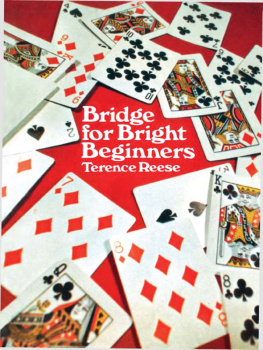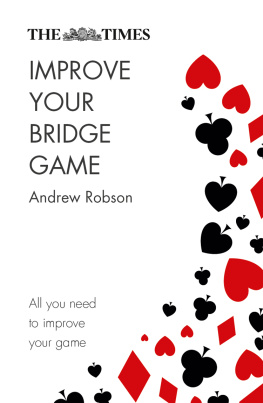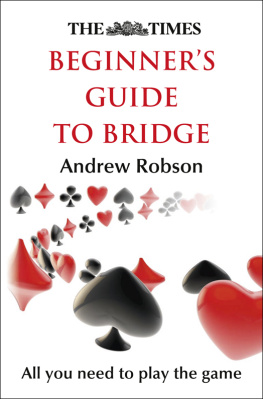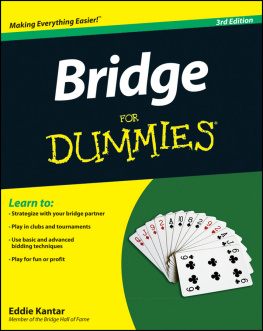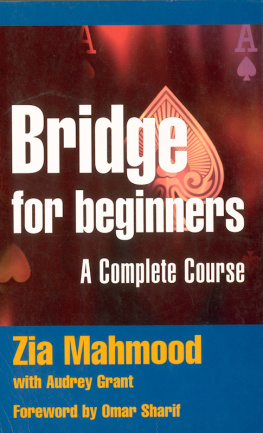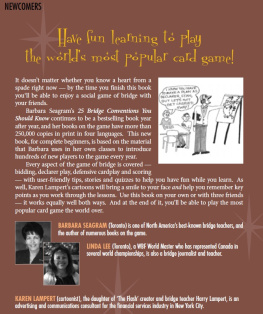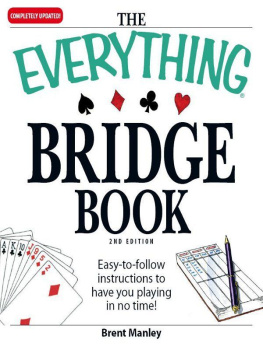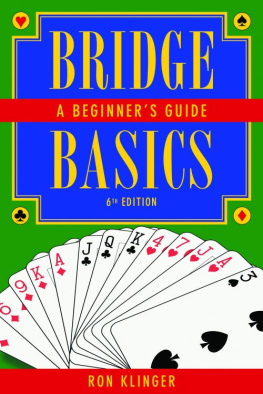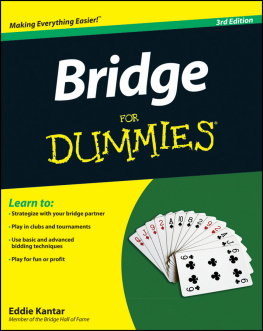BRIDGE FOR
BRIGHT BEGINNERS
by
Terence Reese
DOVER PUBLICATIONS, INC.
NEW YORK
Copyright 1964 by Terence Reese.
All rights reserved under Pan American and International Copyright Conventions.
This Dover edition, first published in 1973, is an unabridged and unaltered republication of the work originally published in 1964. This edition is published by special arrangement with Sterling Publishing Company, Inc., 419 Park Avenue South, New York, New York 10016, publisher of the original edition.
International Standard Book Number: 0-486-22942-4
Library of Congress Catalog Card Number: 73-77446
Manufactured in the United States of America
Dover Publications, Inc., 31 East 2nd Street, Mineola, N.Y. 11501
Contents
You play a complete hand
The cut and deal
Simple overcalls
Oh, if only I had time to learn to play bridge!
Of course you have time. You can get the feel of this game inside half an hour!
To play a real game, you need cards, a table, score-pads, four chairs, and three friends to play with. In a pinch you can dispense with the table, the score-pads, and the friends. You can begin (as I did) by dealing out a deck of cards on the carpet.
Sort the cards, as we say, into suits, so that they look like this:

There are 13 cards in each of the four suits. These lines show how they rank in bridge. That is to say, the Ace is a better card than the King, the King than the Queen, and so on. The order is not difficult to remember, except perhaps that the Ace counts high. You would expect the King to rank higher than the Queen, and of course the Jack (or Knave, as it is sometimes called) ranks below the throne.
The five top cards, Ace King Queen Jack Ten, are called HONORS . They possess no special magic in the play, but in certain circumstances you score a bonus simply for holding honors.
We have put the suits in order, toospades, hearts, diamonds, and clubs. The suits rank this way, spades better than hearts, etc., but that will not concern us in the first two chapters.
There were two reasons why I asked you to lay out a deck of cards in this fashion. One was that you would see how the cards (and suits) rank in bridge; the other so that, with the 52 cards sorted into suits, you could easily pick them out and reproduce the deal below. For you are going to play a hand of bridge right now!
First, look at the North hand in the diagram and pick out the cards you want. Set this opposite to yourself, for you are going to be South. Then pick out the West hand, followed by the East hand. If you havent made any mistakes so far, the thirteen cards left will form the South hand.

Now that you have set out the deal in this fashion, with the cards in a suit going from left to right, I want you to change each layout or hand so that the cards actually lie like this:

In writing, we use the horizontal form, because it is easier to read as the eye travels across. When you are actually laying the cards out to play, the vertical arrangement is more convenient.
I should add that North, South, East and West are not meaningful terms in an actual game of bridge where the players all have names. They are simply used for convenience in writing, to designate the players. North and South are partners, playing against the partnership of East and West.
One other point: You will find that you can pick out the cards more readily if the BLACK and RED SUITS are arranged alternately in your hand. Most players do sort their cards like that, and so should you. It makes no difference, however, so long as you pick from the right suit when you play a card.
The first trick
Now we can begin. You, South, are the man at the wheel, known in bridge as the DECLARER . (In written bridge hands, you will almost always find that South is the declarer.) The opponent on your left, West, makes the first play or LEAD by putting a card face up in the middle of the table. Let us say that he leads the 4 of clubs, which would be a sound choice from his hand. Now you have to play a card from Norths, your partners, hand opposite. The rules of the game require that a player must, if possible, contribute a card of the same suit as has been led. You have therefore the choice between the 7 and 6. These cards are in effect the same, being next to one another in rank, so you play the 6. East plays next, and he puts on his highest club, the Queen. You have a still higher club, the King, and you play it.
That completes the first TRICK . You have played the highest card, the King, so you have won the trick. You collect the four cards and turn them face downward in front of you.
Quite a simple operation, but you have already learned the meaning of three important terms in bridge: declarer, lead and trick. Add one more to your stock: the players on the other side, East and West when you are South, are called the DEFENDERS , and play the DEFENSE.
Tricks two to nine
You have won the first trick with the King of clubs. What next? It doesnt matter a lot on this hand, but your eye will probably be caught by the diamonds, where you and North between you hold all the top cards. Because you won the last trick in your hand, you have the privilege of making the next lead and you choose the Ace of diamonds. West plays the 5. As you have already played a winning card, there is no point in putting on the King or Queen from North, your partners hand. You play the 3. In the same way it would be pointless for East to contribute one of his higher cards. He plays the 2.
Thats the second trick won by your side. You gather the cards again, turn them over, and lay them across the first trick. It is your lead again, for you played the winning card.
Trick 3 Continuing diamonds, you play the 4 and this time win in the North hand with the King. West plays the 9 and East the 7.
Trick 4 Now North has the lead. You play the 3 of diamonds from North, East plays the 10, and you (South) the Jack, making sure that you win the trick. West has no more diamonds, so he has to play a card of another suit. This is called DISCARDING . As he may hope to win tricks sooner or later with his clubs, West discards the 7 of spades.
Trick 5 You lead your fourth diamond, the 8, towards Norths Queen. West discards the 5 of hearts this time, and East the 3 of spades.
Trick 6 You still do not wish to surrender the lead because you know that the defenders have several clubs to make as soon as they come in to lead them. You lead the 2 of hearts from North and play the King. You know that this must win because the Acethe only card to beat the Kingis held by North. East plays the 6 of hearts on this trick and West the 10. (Remember that West has already discarded one heart.)
Trick 7 You are still in (on lead) with the King of hearts, so you lead the 3. West must play his last heart, the Queen; the North hand plays the Ace, and East the 9.
Trick 8 You have two more certain tricks, the King and Ace of spades. From North you lead the King of spades, East plays the 4, you the 3, and West the 9.
Trick 9 The 2 of spades is led from North to your Ace. East plays the 10 and West the Jack.
Tricks ten to thirteen
You have won the first nine tricks and there are four cards left in each hand. As you can see, you have no chance of making any more tricks, for East has the best spade, the Queen, and the best heart, the Jack. If you lead either suit, East will win the trick and then CASH his other high card. Then he will lead a club, and West will win the last two tricks with his high clubs. If, instead, you should lead a club at the tenth trick, West will win the last four tricks himself.
Next page
